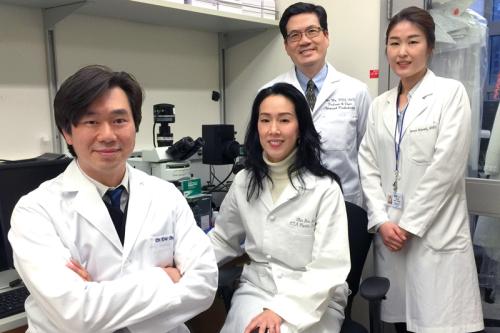
Growing bone in space: UCLA and CASIS announce pioneering collaborative study to test therapy for bone loss on the international space station
UCLA has received grant funding from the Center for the Advancement of Science in Space (CASIS) to lead a research mission that will send rodents to the International Space Station (ISS). The mission will allow astronauts on the space station and scientists on Earth to test a potential new therapy for accelerating bone growth in humans.
The research will be led by UCLA professor of plastic and reconstructive surgery and orthopaedic surgery, Dr. Chia Soo, who is member of the Eli and Edythe Broad Center of Regenerative Medicine and Stem Cell Research and research director for UCLA Operation Mend, which provides medical care for wounded warriors. It will test the ability of a bone-forming molecule called NELL-1 to direct stem cells to induce bone formation and prevent bone degeneration.
Other members of the UCLA research team are Dr. Kang Ting, a professor and chairman in dentistry who discovered NELL-1 and is leading efforts to translate NELL-1 therapy to humans, Dr. Ben Wu, a professor and chairman in bioengineering who modified the NELL-1 molecule to make osteoporosis treatment possible, and Dr. Jin Hee Kwak, an assistant professor in dentistry who will manage daily operations.
Based on results from studies supported by the NIH, the UCLA-ISS team will begin ground operations in early 2015. The UCLA-ISS team hopes that the findings will provide new insights into the prevention of bone loss or osteoporosis as well as the regeneration of massive bone defects that can occur in wounded military personnel. Osteoporosis is a significant public health problem commonly associated with “skeletal disuse” conditions such as immobilization, stroke, cerebral palsy, muscular dystrophy, spinal cord injury and jaw resorption after tooth loss.
“NELL-1 holds tremendous hope that not only can we prevent bone loss, but one day even restore healthy bone,” Ting said. “For patients who are bed-bound and suffering from bone loss, it could be life-changing.”
The UCLA team will oversee the ground operations of the mission in tandem with a flight operation coordinated by CASIS and NASA.
“A group of 40 rodents will be sent to the International Space Station U.S. National Laboratory onboard the SpaceX Dragon capsule, where they will live for two months in a microgravity environment during the first ever test of NELL-1 in space,” said Dr. Julie Robinson, NASA’s chief scientist for the International Space Station program at the Johnson Space Center.
“CASIS is proud to work alongside UCLA in an effort to promote the station as a viable platform for bone loss inquiry,” said Warren Bates, director of portfolio management for CASIS. “Through investigations like this, we hope to make profound discoveries and enable the development of therapies to counteract bone loss ailments common in humans.”
Prolonged space flights induce extreme changes in bone and organ systems that cannot be replicated on Earth.
“Besides testing the limits of NELL-1’s robust bone-producing effects, this mission will provide new insights about bone biology and could uncover important clues for curing diseases such as osteoporosis," Wu said.
“NIH has been pleased to work with NASA and CASIS to encourage the use of the International Space Station as a unique microgravity environment that can test innovative hypotheses that will benefit human health on Earth,” said Dr. Joan A. McGowan, director of the division of musculoskeletal diseases at the National Institute of Arthritis and Musculoskeletal and Skin Diseases, part of the NIH.
“This research has enormous translational application for astronauts in space flight and for patients on Earth who have osteoporosis or other bone-loss problems from disease, illness or trauma,” Soo said. “We very much appreciate the dedicated review staff at CASIS and the Center for Scientific Review, the portal for NIH grant applications, that made this ISS-NIH effort possible.”
This research is supported by grants from the Center for the Advancement of Science in Space and National Institutes of Health. Additional funding and support are provided by the Eli and Edythe Broad Center of Regenerative Medicine and Stem Cell Research at UCLA, UCLA School of Dentistry, and Department of Orthopaedic Surgery and Orthopaedic Hospital Research Center.